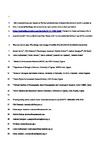They are here to stay: The biology and ecology of lionfish (Pterois miles ) in the Mediterranean Sea
| dc.contributor.author | Savva, I | |
| dc.contributor.author | Chartosia, N | |
| dc.contributor.author | Antoniou, C | |
| dc.contributor.author | Kleitou, Periklis | |
| dc.contributor.author | Georgiou, A | |
| dc.contributor.author | Stern, N | |
| dc.contributor.author | Hadjioannou, L | |
| dc.contributor.author | Jimenez, C | |
| dc.contributor.author | Andreou, V | |
| dc.contributor.author | Hall-Spencer, Jason | |
| dc.contributor.author | Kletou, D | |
| dc.date.accessioned | 2020-04-21T17:58:29Z | |
| dc.date.issued | 2020-07 | |
| dc.identifier.issn | 0022-1112 | |
| dc.identifier.issn | 1095-8649 | |
| dc.identifier.uri | http://hdl.handle.net/10026.1/15585 | |
| dc.description | 12 months embargo applied | |
| dc.description.abstract |
<jats:title>Abstract</jats:title><jats:p>The lionfish, <jats:italic>Pterois miles</jats:italic>, is one of the most recent Lessepsian immigrants into the Mediterranean Sea, and it poses a serious threat to marine ecosystems in the region. This study assesses the basic biology and ecology of lionfish in the Mediterranean, examining morphometrics, reproduction and diet as well as population structure and distribution. The population density of lionfish has increased dramatically in Cyprus since the first sighting in late 2012; by 2018 aggregations of up to 70 lionfish were found on rocky grounds with complex reefs and artificial reefs in depths of 0–50 m. Lionfish in Cyprus become mature within a year, and adults are capable of spawning year‐round, with peak spawning in summer when the sea‐surface temperature reaches 28.4°C. The Cypriot lionfish grow faster and bigger than in their native range, and females are more common than males. Lionfish are generalist predators in these waters, as also found in their native range, consuming a range of teleost and crustacean prey, some of which are of high economic value (<jats:italic>e.g.</jats:italic>, <jats:italic>Spicara smaris</jats:italic> and <jats:italic>Sparisoma cretense</jats:italic>) or have an important role in local trophic webs (<jats:italic>e.g.</jats:italic>, <jats:italic>Chromis chromis</jats:italic>). Overall, the reproductive patterns, the presence of juveniles and adults throughout the year, the rapid growth rates and the generalist diet indicate that lionfish are thriving and are now already well established in the region and could potentially become the serious nuisance that they are in their temperate and tropical western Atlantic–invasive range.</jats:p> | |
| dc.format.extent | 148-162 | |
| dc.format.medium | Print-Electronic | |
| dc.language | en | |
| dc.language.iso | en | |
| dc.publisher | Wiley | |
| dc.subject | Cyprus | |
| dc.subject | growth rate | |
| dc.subject | Lessepsian migration | |
| dc.subject | marine invasive species | |
| dc.subject | population structure | |
| dc.subject | trophic relations | |
| dc.title | They are here to stay: The biology and ecology of lionfish (Pterois miles ) in the Mediterranean Sea | |
| dc.type | journal-article | |
| dc.type | Journal Article | |
| plymouth.author-url | https://www.webofscience.com/api/gateway?GWVersion=2&SrcApp=PARTNER_APP&SrcAuth=LinksAMR&KeyUT=WOS:000527888400001&DestLinkType=FullRecord&DestApp=ALL_WOS&UsrCustomerID=11bb513d99f797142bcfeffcc58ea008 | |
| plymouth.issue | 1 | |
| plymouth.volume | 97 | |
| plymouth.publication-status | Published | |
| plymouth.journal | Journal of Fish Biology | |
| dc.identifier.doi | 10.1111/jfb.14340 | |
| plymouth.organisational-group | /Plymouth | |
| plymouth.organisational-group | /Plymouth/Faculty of Science and Engineering | |
| plymouth.organisational-group | /Plymouth/Faculty of Science and Engineering/School of Biological and Marine Sciences | |
| plymouth.organisational-group | /Plymouth/PRIMaRE Publications | |
| plymouth.organisational-group | /Plymouth/REF 2021 Researchers by UoA | |
| plymouth.organisational-group | /Plymouth/REF 2021 Researchers by UoA/UoA07 Earth Systems and Environmental Sciences | |
| plymouth.organisational-group | /Plymouth/Research Groups | |
| plymouth.organisational-group | /Plymouth/Research Groups/Marine Institute | |
| plymouth.organisational-group | /Plymouth/Users by role | |
| plymouth.organisational-group | /Plymouth/Users by role/Academics | |
| dc.publisher.place | England | |
| dcterms.dateAccepted | 2020-04-01 | |
| dc.rights.embargodate | 2021-4-6 | |
| dc.identifier.eissn | 1095-8649 | |
| dc.rights.embargoperiod | Not known | |
| rioxxterms.versionofrecord | 10.1111/jfb.14340 | |
| rioxxterms.licenseref.uri | http://www.rioxx.net/licenses/all-rights-reserved | |
| rioxxterms.type | Journal Article/Review |


